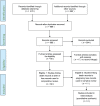Pregnancy associated death in record linkage studies relative to delivery, termination of pregnancy, and natural losses: A systematic review with a narrative synthesis and meta-analysis
- PMID: 29163945
- PMCID: PMC5692130
- DOI: 10.1177/2050312117740490
Pregnancy associated death in record linkage studies relative to delivery, termination of pregnancy, and natural losses: A systematic review with a narrative synthesis and meta-analysis
Abstract
Objectives: Measures of pregnancy associated deaths provide important guidance for public health initiatives. Record linkage studies have significantly improved identification of deaths associated with childbirth but relatively few have also examined deaths associated with pregnancy loss even though higher rates of maternal death have been associated with the latter. Following PRISMA guidelines we undertook a systematic review of record linkage studies examining the relative mortality risks associated with pregnancy loss to develop a narrative synthesis, a meta-analysis, and to identify research opportunities.
Methods: MEDLINE and SCOPUS were searched in July 2015 using combinations of: mortality, maternal death, record linkage, linked records, pregnancy associated mortality, and pregnancy associated death to identify papers using linkage of death certificates to independent records identifying pregnancy outcomes. Additional studies were identified by examining all citations for relevant studies.
Results: Of 989 studies, 11 studies from three countries reported mortality rates associated with termination of pregnancy, miscarriage or failed pregnancy. Within a year of their pregnancy outcomes, women experiencing a pregnancy loss are over twice as likely to die compared to women giving birth. The heightened risk is apparent within 180 days and remains elevated for many years. There is a dose effect, with exposure to each pregnancy loss associated with increasing risk of death. Higher rates of death from suicide, accidents, homicide and some natural causes, such as circulatory diseases, may be from elevated stress and risk taking behaviors.
Conclusions: Both miscarriage and termination of pregnancy are markers for reduced life expectancy. This association should inform research and new public health initiatives including screening and interventions for patients exhibiting known risk factors.
Keywords: Maternal mortality; abortion; health policy; longevity; miscarriage; pregnancy associated death; pregnancy loss; pregnancy screening; risk factors; termination of pregnancy.
Conflict of interest statement
Declaration of conflicting interests: The author(s) declared no potential conflicts of interest with respect to the research, authorship, and/or publication of this article.
Figures








Similar articles
-
Beyond the black stump: rapid reviews of health research issues affecting regional, rural and remote Australia.Med J Aust. 2020 Dec;213 Suppl 11:S3-S32.e1. doi: 10.5694/mja2.50881. Med J Aust. 2020. PMID: 33314144
-
Pregnancy loss managed by cervical dilatation and curettage increases the risk of spontaneous preterm birth.Hum Reprod. 2013 Dec;28(12):3197-206. doi: 10.1093/humrep/det332. Epub 2013 Sep 19. Hum Reprod. 2013. PMID: 24052504
-
Identifying maternal deaths with the use of hospital data versus death certificates: a retrospective population-based study.CMAJ Open. 2021 May 21;9(2):E539-E547. doi: 10.9778/cmajo.20200201. Print 2021 Apr-Jun. CMAJ Open. 2021. PMID: 34021011 Free PMC article.
-
Advanced paternal age is associated with an increased risk of spontaneous miscarriage: a systematic review and meta-analysis.Hum Reprod Update. 2020 Sep 1;26(5):650-669. doi: 10.1093/humupd/dmaa010. Hum Reprod Update. 2020. PMID: 32358607 Free PMC article.
-
[SENTIERI - Epidemiological Study of Residents in National Priority Contaminated Sites. Sixth Report].Epidemiol Prev. 2023 Jan-Apr;47(1-2 Suppl 1):1-286. doi: 10.19191/EP23.1-2-S1.003. Epidemiol Prev. 2023. PMID: 36825373 Italian.
Cited by
-
Induced Abortion and the Increased Risk of Maternal Mortality.Linacre Q. 2020 Aug;87(3):302-310. doi: 10.1177/0024363920922687. Epub 2020 May 12. Linacre Q. 2020. PMID: 32699440 Free PMC article.
-
Improving the Metrics and Data Reporting for Maternal Mortality: A Challenge to Public Health Surveillance and Effective Prevention.Online J Public Health Inform. 2019 Sep 19;11(2):e17. doi: 10.5210/ojphi.v11i2.10012. eCollection 2019. Online J Public Health Inform. 2019. PMID: 31632611 Free PMC article.
-
The Enduring Association of a First Pregnancy Abortion with Subsequent Pregnancy Outcomes: A Longitudinal Cohort Study.Health Serv Res Manag Epidemiol. 2022 Oct 11;9:23333928221130942. doi: 10.1177/23333928221130942. eCollection 2022 Jan-Dec. Health Serv Res Manag Epidemiol. 2022. PMID: 36246345 Free PMC article.
-
The abortion and mental health controversy: A comprehensive literature review of common ground agreements, disagreements, actionable recommendations, and research opportunities.SAGE Open Med. 2018 Oct 29;6:2050312118807624. doi: 10.1177/2050312118807624. eCollection 2018. SAGE Open Med. 2018. PMID: 30397472 Free PMC article. Review.
-
A Cohort Study of Mental Health Services Utilization Following a First Pregnancy Abortion or Birth.Int J Womens Health. 2023 Jun 15;15:955-963. doi: 10.2147/IJWH.S410798. eCollection 2023. Int J Womens Health. 2023. PMID: 37342485 Free PMC article.
References
-
- Gissler M, Berg C, Bouvier-Colle M-H, et al. Methods for identifying pregnancy-associated deaths: population-based data from Finland 1987–2000. Paediatr Perinat Epidemiol 2004; 18(6): 448–455. - PubMed
-
- Fergusson DM, Horwood LJ, Boden JM. Does abortion reduce the mental health risks of unwanted or unintended pregnancy? A re-appraisal of the evidence. Aust N Z J Psychiatry 2013; 47(9): 819–827. - PubMed
Grants and funding
LinkOut - more resources
Full Text Sources
Other Literature Sources

